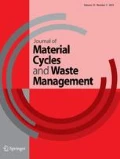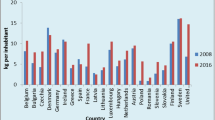Abstract
Nowadays, a large quantity of Light Emitting Diodes (LEDs) have been produced and updated with the development of optoelectronic industry. At the same time, many waste LEDs are discarded. However, there are many metals and non-metals in waste LEDs, which may cause secondary pollution and waste of resources if disposed improperly. In this study, solvent method was used to dissociate the waste LED modules and recycle resources. Firstly, the components of the waste LED modules were analyzed. The main component of the transparent plastic part, usually used as packaging materials, is cured epoxy resin, and the main component of the white plastic part as the skeleton of LED modules is a mixture of polyphenylene oxide (PPO) and polystyrene (PS). Then, eight organic solvents, [EMIM+]BF4− ion liquid and sodium hydroxide (NaOH) inorganic reagent were tried to separate a 40 × 40 mm2 waste LED module respectively. The results showed that only three organic solvents—dimethylformamide (DMF), dimethylacetamide (DMA), dimethyl-sulfoxide (DMSO) could dissociate the waste LED module very well. The used DMF solution was purified by rotary evaporation, and the regenerative DMF solution could be reused because its property has not changed. The solid residue obtained after rotary evaporating DMF was identified as polystyrene (PS). It was inferred that the waste LED module was dissociated through the DMF dissolving the PS of white plastic. In addition, the effect of DMF, DMA and DMSO dissociating the waste LED modules with the change of temperature was discussed. It was found that the choice of suitable solvent is a key for this method, and the heating temperature was also a very important factor. Finally, it was measured that the cured epoxy resin and the white plastic of the waste LED module accounted for about 31.4% (w/w) and 37.7% (w/w) respectively, which can be recycled. In short, the method not only separated completely the waste LED module and its each part was recycled easily, but the solvents can be reused. This study suggests a new route to recycle LEDs due to its environmentally friendly process, which may exert a significantly beneficial impact on our environment.







Similar content being viewed by others
References
Kumar A, Kuppusamy VK, Holuszko M, Song S, Loschiavo A (2019) LED lamps waste in Canada: generation and characterization. Resour Conserv Recycl 146:329–336
Fang S, Yan W, Cao H, Song Q-B, Zhang Y, Sun Z (2018) Evaluation on end-of-life LEDs by understanding the criticality and recyclability for metals recycling. J Clean Prod 182:624–633
Smallwood P (2014) LED lighting global market trends. Nashua, New Hampshire
Mizanur Rahman SM, Kim J, Lerondel G, Bouzidi Y, Nomenyo K, Clerget L (2017) Missing research focus in end-of-life management of light-emitting diode (LED) lamps. Resour Conserv Recycl 127:256–258
Pourhossein F, Mousavi SM (2018) Enhancement of copper, nickel, and gallium recovery from LED waste by adaptation of Acidithiobacillus ferrooxidans. Waste Manage 79:98–108
Franz M, Wenzl FP (2017) Critical review on life cycle inventories and environmental assessments of led-lamps. Crit Rev Environ Sci Technol 47(21):2017–2078
Reuter MA, Schaik AV (2015) Product-centric simulation-based design for recycling: case of LED lamp recycling. J Sustain Metall 1(1):4–28
Schaik AV, Reuter MA (2014) Product centric design for recycling: predicting recycling rates-an example on LED lamp recycling. Proceedings, Going Green – CARE INNOVATION 2014, November 17-20, At Schönbrunn Palace Conference Centre, Vienna, Austria
Mizanur Rahman SM, Perry N, Müller JM, Kim J, Laratte B (2020) End-of-life in industry 4.0 ignored as before? Resources. Conserv Recycl 154:104539
Mizanur Rahman SM, Kim J, Lerondel G, Bouzidi Y, Clerget L (2019) Value retention options in circular economy: issues and challenges of LED lamp preprocessing. Sustainability 11:4723. https://doi.org/10.3390/su11174723
Ruiz-Mercado GJ, Gonzalez MA, Smith RL, Meyer DE (2017) A conceptual chemical process for the recycling of Ce, Eu, and Y from LED flat panel displays. Resour Conserv Recycl 126:42–49
Murakami H, Nishihama S, Yoshizuka K (2015) Separation and recovery of gold from waste LED using ion exchange method. Hydrometallurgy 157:194–198
Swain B, Mishra C, Kang L, Park KS, Lee CG, Hong HS, Park JJ (2015) Recycling of metal-organic chemical vapor deposition waste of GaN based power device and LED industry by acidic leaching: process optimization and kinetics study. J Power Sources 281:265–271
Zhan L, Xia F, Ye Q, Xiang X, Xie B (2015) Novel recycle technology for recovering rare metals (ga, in) from waste light-emitting diodes. J Hazard Mater 299:388–394
Swain B, Mishra C, Kang L, Park KS, Lee CG, Hong HS (2015) Recycling process for recovery of gallium from GaN an e-waste of led industry through ball milling, annealing and leaching. Environ Res 138:401–408
Chen WS, Hsu LL, Wang LP (2018) Recycling the GaN waste from LED industry by pressurized leaching method. Metals 8:861
Ning C, Lin CSK, HuiMcKay DCW (2017) Waste printed circuit board (PCB) recycling techniques. Top Curr Chem 375(2):43
Shen Y, Chen X, Ge X, Chen M (2018) Thermochemical treatment of non-metallic residues from waste printed circuit board: pyrolysis vs. combustion. J Clean Prod 176:1045–1053
Nekouei RK, Pahlevani F, Rajarao R, Golmohammadzadeh R, Sahajwalla V (2018) Two-step pre-processing enrichment of waste printed circuit boards: mechanical milling and physical separation. J Clean Prod 184:1113–1124
Zhu P, Chen Y, Wang L, Qian G, Zhang WJ, Zhou M (2013) Dissolution of brominated epoxy resins by dimethyl sulfoxide to separate waste printed circuit boards. Environ Sci Technol 47(6):2654–2660
Zhu P, Chen Y, Wang LY, Qian GY, Zhou M, Zhou J (2012) A new technology for separation and recovery of materials from waste printed circuit boards by dissolving bromine epoxy resins using ionic liquid. J Hazard Mater 239–240(2012):270–278
Mottier P (2009) LEDs for lighting applications. Wiley, Hoboken
Huang JC, Chu YP, Wei M, Deanin RD (2010) Comparison of epoxy resins for applications in light-emitting diodes. Adv Polym Technol 23:298–306
Wu Y, Zhang H, Shentu B, Weng Z (2017) Relationship between structure and properties in high-performance PA6/SEBS-g-MA/(PPO/PS) blends: the role of PPO and PS. J Appl Polym Sci 134(36):45281
Weng L, Zhang Y, Zhang X, Liu L, Zhang H (2017) Synthesis and properties of cyanate mixed resin systems modified by polyphenylene oxide for production of high-frequency copper clad laminates. J Mater Sci: Mater Electron 29:2831–2840
Hua ZZ, Yu XF, Yuan LF (2009) Determination of the content of each component in polyphenylene oxide-polystyrene blends by fourier transform infrared spectroscopy (in chinese). Chem Anal Meterage 18:16–20
Lé-Magda M, Dargent E, Youssef B, Guillet A, Idrac J, Saiter JM (2012) Thermal properties evolution of PCB FR4 epoxy composites for mechatronic during very long ageing. Macromol Symp 315:143–151
Luis SV, GarcÃa-Verdugo E, Sanchez-Gomez G, Perez J, Serrano JL, Nieto S (2017) Flow biocatalytic processes in ionic liquids and supercritical fluids. Mini Rev Org Chem 14(1):65–74
Leskinen T, King AWT, Argyropoulos DS (2014) Fractionation of lignocellulosic materials with ionic liquids. Production of biofuels and chemicals with ionic liquids, Springer Science+Business Media, Dordrecht, Holland, pp 145–168
Vijayakrishna K, Manojkumar K, Sivaramakrishna A (2015). Ionic liquids as solvents and/or catalysts in polymerization. Applications of ionic liquids in polymer science and technology, Springer-Verlag, Berlin Heidelberg, Berlin, Germany, pp 355–387
Gehrke S, Von Domaros M, Clark R, Hollóczki O, Brehm M, Welton T (2017) Structure and lifetimes in ionic liquids and their mixtures. Faraday Discuss 206:219–245
Acknowledgements
The work was supported by National Key R&D Program of China (No. 2018YFC0213600), Program of Innovative Research Team in University (IRT13078), the Funds of Jiahua Science and Technology Bureau (Grant No: 2013-3-001), the Funds of Jinhua Environmental Protection Bureau (Grant No: YG2014-FW673-ZFCG046), and the Research Fund of Shaanxi Key Laboratory of Comprehensive Utilization of Tailings Resources (Shangluo University).
Author information
Authors and Affiliations
Corresponding author
Additional information
Publisher's Note
Springer Nature remains neutral with regard to jurisdictional claims in published maps and institutional affiliations.
Electronic supplementary material
Below is the link to the electronic supplementary material.
Rights and permissions
About this article
Cite this article
Zhu, P., Ma, Y., Wang, Y. et al. Separation and recovery of materials from the waste light emitting diode (LED) modules by solvent method. J Mater Cycles Waste Manag 22, 1184–1195 (2020). https://doi.org/10.1007/s10163-020-01012-7
Received:
Accepted:
Published:
Issue Date:
DOI: https://doi.org/10.1007/s10163-020-01012-7




